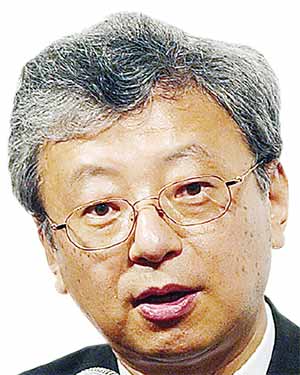9:12 JST, February 3, 2023
There is a way of approaching economic policy with what is dubbed a policy mix. It requires policymakers to combine multiple policy tools when they want to realize multiple policy goals.
Let’s take, for example, two such policy goals: to put the economy on a recovery track and to stabilize prices.
When an economy is not in good shape while facing a deflationary trend, such economic phenomena can be dealt with through monetary easing. An expansionary fiscal package is also feasible in tackling both troubling conditions. Each approach is likely to bring about a result that looks like killing two birds with one stone. In this case, no big problem is expected to arise in the process of choosing the right policy mix.
What then about stagflation, a combination of stagnant economic growth and high inflation? Monetary tightening is likely to be effective in containing price increases. To stimulate the economy, an expansionary fiscal package can be implemented. In this scenario, it is crucially important to adopt monetary and fiscal approaches for different purposes.
Given the economic situation in Japan, it is clear how increasingly important it is to discuss possible policy mix solutions.
For nearly 10 years up until the outbreak of the novel coronavirus, monetary easing was truly effective in stemming deflation and an economic downturn. Although there was on-and-off debate over how much fiscal policy should be used to stimulate the Japanese economy, the government chose all the time — until the eruption of the pandemic — to manage public finances in a restrained manner.
Take a look at comparisons between fiscal 2012, when so-called Abenomics was launched in earnest, and fiscal 2018 before the COVID-19 crisis. When calculated as a percentage of Japan’s gross domestic product, the fiscal deficit decreased from 6.9% to 3.2% over that period. Likewise, the primary balance, which excludes interest payments on public debt, showed the deficit contracting from 5.7% to 2.3%.
Over the same period, the government raised the consumption tax rate from 5% to 10% to uphold its policy of keeping public finances on a sound footing as an essential way of eventually turning the primary balance into a surplus.
Monetary policy normalization
This means that monetary policy was solely responsible for both ending deflation and stimulating the economy. This approach has now reached a major turning point as prices in Japan have been insidiously rising amid global inflation.
To help Japan get rid of deflation, the Bank of Japan has employed three extraordinary monetary strategies — quantitative monetary easing; negative interest rates; and yield-curve control, a monetary operation controlling short- and long-term interest rates to seek a decline in real interest rates.
As those monetary policy frameworks were introduced as unavoidable measures to overcome deflation, certain adverse effects have been pointed out. Now that deflation is no longer present, they cannot be sustained indefinitely.
In other advanced nations, one central bank after another is already in the process of normalizing monetary policy amid rising prices.
If and when Japan’s consumer prices keep rising more than 2% year over year from now on, the Bank of Japan should terminate its extraordinary deflation-fighting monetary policy.
How should fiscal policy be conducted, provided that the Bank of Japan decides to switch from ultra-easy monetary policy to normalization in response to price increases?
What particularly matters is how the Japanese economy is likely to evolve in the years ahead. The world economy is forecast to fall into recession — Japan is no exception. Thanks to a rebound from the pandemic, demand in the Japanese economy is expected to keep growing for a while. But Japan’s recovery is likely to be short-lived.
A sharp increase in energy prices and the destabilization of supply chains triggered or exacerbated by the Ukraine situation will certainly have an adverse impact on economic recovery. Above all, many advanced nations are still suffering from the prolonged stagnation that began well before the outbreak of the COVID-19 crisis. As such, this trend can hardly be said to be undergoing a major change.
Keywords: Green, digital
Under such circumstances, there has emerged an interesting development in Western nations regarding their fiscal stimuli.
The European Union has adopted the European Green Deal, a package of active fiscal measures aimed at luring massive investment for facilitating the region’s efforts to combat climate change. For its part, the United States is about to mobilize fiscal solutions for accelerating investment related to climate change and digital assets.
In Japan, too, the government has begun introducing policy initiatives, using the words “green” and “digital” as keywords, with a view to accelerating investment from the private sector.
Despite the Bank of Japan’s bold monetary easing, Japan’s economic growth rate has been sluggish. The biggest reason for this is that the amount of domestic investment in Japan has been extremely meager. Without an increase in private investment, it is impossible to expect the economy to move on to a recovery process.
The Bank of Japan has stuck to monetary easing of unprecedented scale, but its policy has gone effectively nowhere in terms of boosting investment by the private sector. As long as the Japanese economy remains as it is, monetary policy is not expected to suddenly become effective in stimulating private investment in the future.
For that reason, expectations are growing for fiscal policy to play a pivotal role in changing the status quo. What is expected of fiscal policy management this time is not to generate demand by repeating those past macroeconomic remedies such as public works spending and tax reductions but to stimulate private investment to genuinely grow.
The government is set to embark on the issuance of so-called green transformation economy transition bonds in fiscal 2023 to financially support the Paris Agreement-compliant commitment to decarbonization. The proceeds of the bond issuance, expected to amount to ¥20 trillion, will be used as a conduit to generate more than ¥150 trillion worth of public and private green transformation investments over the coming 10 years. While the government’s fiscal engagement in the said endeavor is not small, much more is expected of the private sector.
Essentially, this fiscal policy is closer to an industrial policy, as the government will be spearheading efforts to attract private investment. The ¥20 trillion debt will be repaid by procuring resources through a proposed carbon pricing system, which will require businesses to pay for their carbon dioxide emissions. In other words, this approach will not result in fiscal deficits.
Similar policy approaches by the Japanese government to advance digital development have recently been seen.
Follow approach with TSMC
The most notable example is the government’s financial support of up to ¥476 billion for Taiwan Semiconductor Manufacturing Co.’s (TSMC) plan to build a major chip plant in Kumamoto Prefecture with production due to start in late 2024. The government thus played a key role in attracting the world’s largest contract semiconductor foundry to set up a facility in Japan.
Private investment to be generated in connection with TSMC’s Kumamoto project is likely to reach a considerable amount. In fact, a new major flow of investment for a semiconductor ecosystem — investment for the chip plant construction and investment by a variety of companies to meet an increase in the provision of material and manufacturing systems — seems to be finally in the offing in Japan.
The growth of investment similar to the abovementioned one is receiving a boost, with the government now focusing on the aspect of its industrial policy for building stable supply chains to cope robustly with geopolitical risks and ensure economic security.
Of course, as Japan is plagued with massive public-sector debt, the government should refrain from relying easily on fiscal stimuli. Even so, efforts such as raising taxes to address the prodigious issue of how to cope with fiscal deficits — for which snowballing social security expenditures are mainly to blame — do not constitute a hindrance to actively promoting industrial policy initiatives.
With the adoption of such valuable keywords as “green” and “digital,” Japan is on the cusp of seizing a new big chance to increase domestic investment. What is key to making sure this will really happen is the mobilization of industrial policy. It is my hope that the government will proceed for a while with the promotion of policy mix solutions in parallel with the normalization of monetary policy, which has so far been tilted toward excessive quantitative easing.

Motoshige Itoh
Itoh is a professor emeritus at the University of Tokyo. He also served as a professor with the Faculty of International Social Sciences at Gakushuin University until March 2022.
The original article in Japanese appeared in the Jan. 29 issue of The Yomiuri Shimbun.
"Editorial & Columns" POPULAR ARTICLE
-

Violations of Subcontract Law: Major Automakers Must Eliminate Old Practices
-

Local Governments’ Tax Revenues: Devise Ways to Correct Imbalances in Tax Sources
-

5 Japanese Business Dinner Mistakes to Avoid — and What They Taught Me About Business in Japan
-

Heavy Rains in Asia: Support for Victims, Flood-Control Measures Urgently Needed
-

Rice Coupons: A Misguided Approach to Countering Rising Prices
JN ACCESS RANKING
-

Tokyo Economic Security Forum to Hold Inaugural Meeting Amid Tense Global Environment
-

Keidanren Chairman Yoshinobu Tsutsui Visits Kashiwazaki-Kariwa Nuclear Power Plant; Inspects New Emergency Safety System
-

Imports of Rare Earths from China Facing Delays, May Be Caused by Deterioration of Japan-China Relations
-

University of Tokyo Professor Discusses Japanese Economic Security in Interview Ahead of Forum
-

Japan Pulls out of Vietnam Nuclear Project, Complicating Hanoi’s Power Plans
























